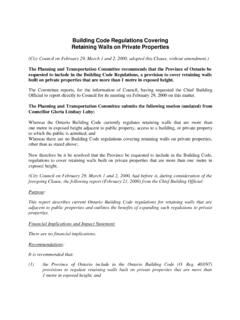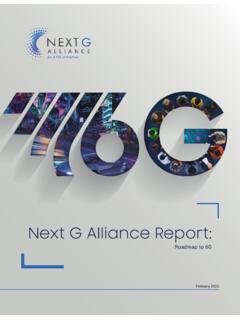Transcription of GUIDELINES FOR USING SYNCHRO 9 - Toronto
1 TRAFFIC MANAGEMENT CENTRE. INTELLIGENT transportation SYSTEMS (OPERATIONS). GUIDELINES FOR USING SYNCHRO 9. (INCLUDING SIMTRAFFIC 9). March 18, 2016. transportation ITS Operations Services Division Traffic Management Centre DOCUMENT CONTROL. Contact Information For more information related to these GUIDELINES , please contact: Manager, ITS Operations Traffic Management Centre transportation Services Division 703 Don Mills Road, 5th Floor Toronto , M3C 3N3. Phone: 416-392-8826. Amendment History Revision Date No. Details Version (YYYY/MM/DD). Existing " GUIDELINES for USING SYNCHRO 7 (including 1 Draft 2015/08/17. SimTraffic 7" updated for SYNCHRO Version Original draft reviewed by Darryl Spencer (Engineer, 2 ITSO), Pierre Vandall (Project Lead, ITSO), and Draft 2015/09/28. Rajnath Bissessar (Manager, ITSO). Draft reviewed by workshop participants and email respondents: District Traffic Planning - Godly Abraham, Geoffrey Lau, Luigi Nicolucci District Traffic Operations (DTO) Farhad Awabin, Christopher Chahil, Jim Edwards, Muhammad Qamar Final 3 Infrastructure Planning Grace Nzainga 2016/03/18.)
2 (Version 1). Cycling Infrastructure Darryl Olsen Public Realm Sheyda Saneinejad City Planning Diane Ho, Matthew Davis, Nasim Norouzi, Satbinder Pabla, Garvin Tom ITS Operations (ITSO) Rajnath Bissessar, Irem Khan, Pierre Vandall APPROVAL. The version of this document dated March 18, 2016 was approved by the following: Safety and Mobility Committee (SMC) of transportation Services on April 21, 2016. transportation Planning of City Planning on April 26, 2016. TPROW Managers of transportation Services on April 28, 2016. Traffic Management Centre GUIDELINES for USING SYNCHRO 9. ITS Operations (including SimTraffic 9). Table of Contents ABBREVIATIONS .. VI. GLOSSARY .. VIII. EXECUTIVE SUMMARY .. XIII. INTRODUCTION .. 1. Background .. 1. Planning vs. Operational 1. General Information on Data Requirements and SYNCHRO Calculated Values.
3 1. MAP SETTINGS .. 2. LANE SETTINGS .. 3. User Inputs .. 3. Changing the Name of the Approach Direction .. 3. Lanes and Sharing .. 4. Traffic Volume (vph).. 4. Link Distance (m) .. 6. Link Speed (km/h) .. 6. Travel Time (s).. 6. Ideal Saturated Flow (vphpl) .. 6. Lane Width (m) .. 7. Grade (%) .. 7. Area Type .. 7. Storage Length (m) .. 8. Storage Lanes (#).. 8. Right Turn Channelized .. 8. Curb Radius .. 8. Add Lanes (#).. 9. Right Turn on Red (RTOR) .. 9. SYNCHRO Calculated Values .. 9. Lane Utilization Factor .. 9. Right Turn Factor .. 9. Left Turn Factor (Prot) .. 9. transportation i Services Division Traffic Management Centre GUIDELINES for USING SYNCHRO 9. ITS Operations (including SimTraffic 9). Left Turn Factor (Perm) .. 9. Right Ped Bike Factor ..10. Left Ped Factor ..10. Saturated Flow Rate (Prot) ..10.
4 Saturated Flow Rate (Perm) ..10. Saturated Flow Rate (RTOR) ..10. VOLUME SETTINGS ..11. User Inputs ..11. Peak Hour Factor (PHF) ..11. Growth Factor ..12. Heavy Vehicles (%)..12. Bus Blockages (#/hr)..12. Adjacent Parking Lane? ..12. Parking Maneuvers ..12. Traffic from Mid-block (%) ..12. Link OD Volumes ..13. SYNCHRO Calculated Values ..13. Adjusted Flow (vph) ..13. Traffic in Shared Lane (%) ..13. Lane Group Flow (vph) ..13. TIMING SETTINGS ..14. Node Settings - User Inputs ..14. Node# ..14. Control Type ..14. Cycle Length ..15. Lock Offset ..16. Referenced to ..16. Reference Phase ..16. Master Intersection ..16. Yield Point ..16. Mandatory Stop On Yellow ..16. transportation ii Services Division Traffic Management Centre GUIDELINES for USING SYNCHRO 9. ITS Operations (including SimTraffic 9). Timing Settings - User Inputs.
5 17. Turn Type ..17. Protected & Permitted Phases ..18. Detector Phases ..18. Switch Phase ..18. Leading Detector and Trailing Detector ..18. Minimum Initial ..18. Minimum Split ..19. Total Split ..19. Yellow Time ..19. All-Red Time ..19. Lost Time Adjust ..20. Lagging Phase ..20. Allow Lead/Lag Optimize? ..20. Recall Mode ..20. SYNCHRO Calculated Values ..21. Volume to Capacity Queue Length 50th & 95th (m) ..21. PHASING SETTINGS ..23. User Inputs ..23. Vehicle Extensions (Maximum Gap) ..23. Minimum Gap ..23. Time Before Reduce ..24. Time to Reduce ..24. Pedestrian Phase ..24. Walk Flashing Don't Walk ..24. Pedestrian Fixed Force Off ..25. DETECTOR SETTINGS ..25. User Inputs ..25. Number of Detectors ..25. transportation iii Services Division Traffic Management Centre GUIDELINES for USING SYNCHRO 9. ITS Operations (including SimTraffic 9).
6 Switch Phase ..26. Leading Detector ..26. Trailing Detector and Detector 1 Position ..27. Detector Size ..28. Detector Type ..28. Detector Extend ..28. Detector Queue ..28. Detector Delay ..28. SIMULATION SETTINGS ..29. User Inputs ..29. Taper Length ..29. Lane Alignment ..29. Enter Blocked Intersection ..30. Link Offset ..30. Crosswalk Width ..30. Two-Way Left Turn Lane (TWLTL) Median ..30. Turning Speed (km/h) ..30. HCM 2010 SETTINGS ..31. Signalized Intersections Auto Mode ..31. HCM 2010 Intersection HCM 2010 Settings ..35. Signalized Intersections Pedestrian Mode ..39. HCM 2010 Pedestrians Settings ..39. HCM 2010 Crosswalk Settings ..40. Signalized Intersections Bicycle HCM 2010 Bicycle Mode Settings ..44. HCM Bicycle Settings ..44. Two-way Stop Control Intersections Auto Mode ..47. HCM 2010 Intersection ..47.
7 Movement Settings ..48. HCM 2010 Two-way Stop Control Intersections Pedestrian Mode ..50. transportation iv Services Division Traffic Management Centre GUIDELINES for USING SYNCHRO 9. ITS Operations (including SimTraffic 9). HCM 2010 Pedestrians ..50. HCM 2010 Crosswalk ..51. All-way Stop Control Intersections ..53. HCM 2010 Intersection ..53. Movement Settings ..53. HCM 2010 Lane Settings ..54. SPECIAL CONSIDERATIONS ..55. Signal Coordination ..55. Model Calibration ..55. Volume Balancing ..55. HOV Streetcars ..57. Transit Priority ..57. Traffic Adaptive ..57. Bicycle Lanes ..58. Offset Intersections ..58. SIMTRAFFIC ..59. REPORTS ..60. REFERENCES ..61. transportation v Services Division Traffic Management Centre GUIDELINES for USING SYNCHRO 9. ITS Operations (including SimTraffic 9). Abbreviations APS Accessible Pedestrian Signal ATCS Adaptive Traffic Control System AWSC All-way-Stop Control CBD Central Business District CCG Canadian Capacity Guide (for Signalized Intersections).
8 DTO District Traffic Operations FDW Flashing Don't Walk HCM 2000 Highway Capacity Manual 2000 (US). HCM 2010 Highway Capacity Manual 2010 (US). HOV High Occupancy Vehicles fLU Lane Utilization Factor LOS Level of Service MOC Mode of Control MOE Measure of Effectiveness OD Origin-Destination OTC Ontario Traffic Council pcphgpl passenger car per hour of green per lane Ped Pedestrian PHF Peak Hour Factor Prot Protected Phase Perm Permissive Phase RTOR Right turn on red transportation vi Services Division Traffic Management Centre GUIDELINES for USING SYNCHRO 9. ITS Operations (including SimTraffic 9). SA Semi-actuated SAP Semi-actuated Pedestrian SAV Semi-actuated Vehicle SCOOT Split, Cycle and Offset Optimization Technique sqrt Square Root TMC Turning Movement Count TSU City's Traffic Safety Unit TWLTL Two-way Left Turn Lane TSOG Traffic Signal Operations Group of ITS Operations TSP Transit Signal Priority TWSC Two-way-Stop Control v/c Volume to capacity ratio vph Vehicles per hour vphpl Vehicles per hour per lane v50 50th Percentile Volume v95 95th Percentile Volume V15 Peak 15 minute volume V60 Peak hour volume Veh Vehicles transportation vii Services Division Traffic Management Centre GUIDELINES for USING SYNCHRO 9.
9 ITS Operations (including SimTraffic 9). Glossary Accessible Signal devices designed to assist pedestrians who are visually and/or Pedestrian hearing impaired by providing information that they can interpret to Signals (APS) understand when they may cross at a signalized intersection. Adaptive Traffic A traffic control system that automatically adjusts signal timing Control System parameters in real-time to allow for signal operations that respond to (ATCS) actual, real-time traffic conditions. Capacity The maximum rate at which vehicles can pass through a given point in an hour under prevailing conditions, known as the saturation flow rate, applied in conjunction with the ratio of time during which vehicles may enter the intersection. Controller (Timer) A device that controls traffic at an intersection by alternating the right- of-way between conflicting streams of vehicular traffic, or vehicular traffic and pedestrians crossing a roadway.
10 Coordinated Signal operation in coordination with other signalized intersections, Actuated and USING vehicle, bicycle, and/or pedestrian detection to define signal timing. Coordination The ability to coordinate multiple signalized intersections to enhance the operation of one or more directional movements in a system. Cycle Length The time required to complete a full sequence of signal indications at a signalized intersection. Delay The additional travel time experienced by a driver, passenger, or pedestrian. Detector A device used to count and/or determine the presence of a vehicle, bicycle, or pedestrian. Double Cycle A cycle length that is half the duration of the cycle length of other signals in a coordinated system Effective Green The time during which vehicles in a given traffic movement proceed Time through the signalized intersection.













